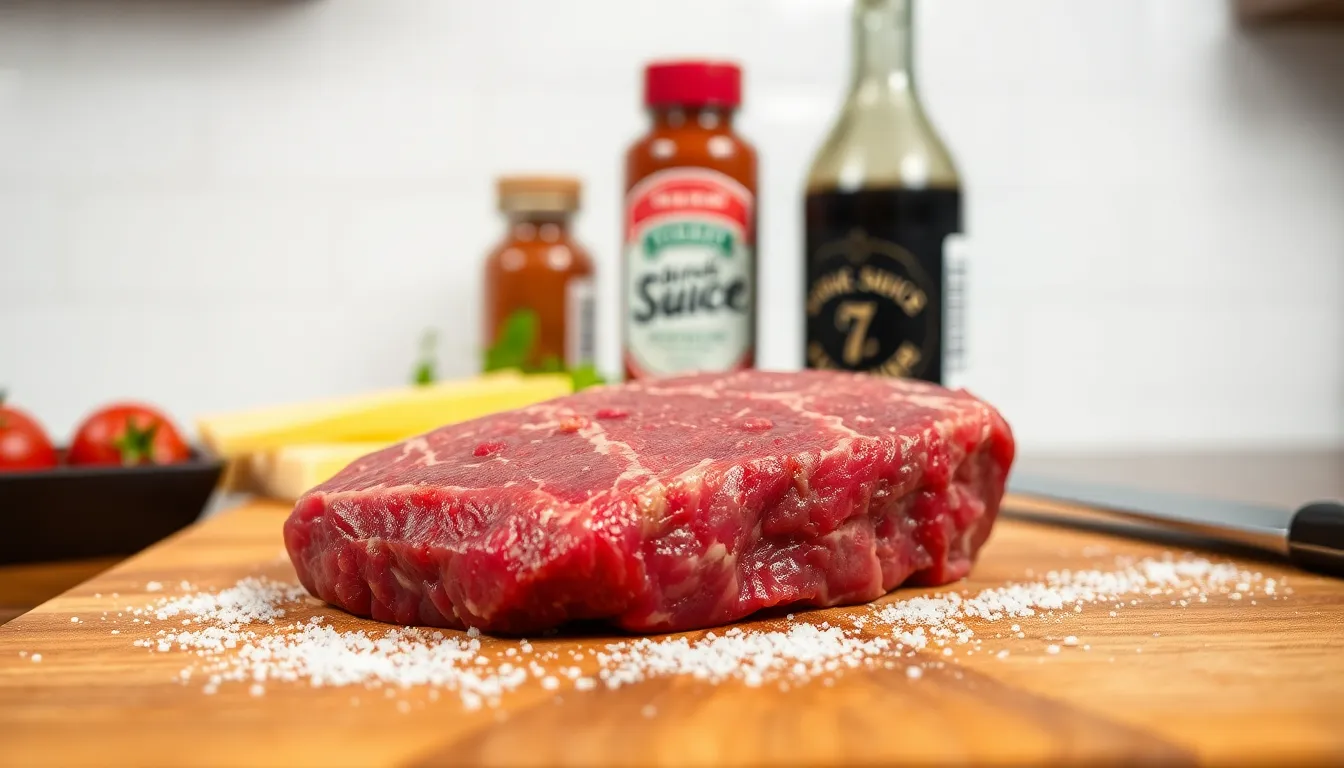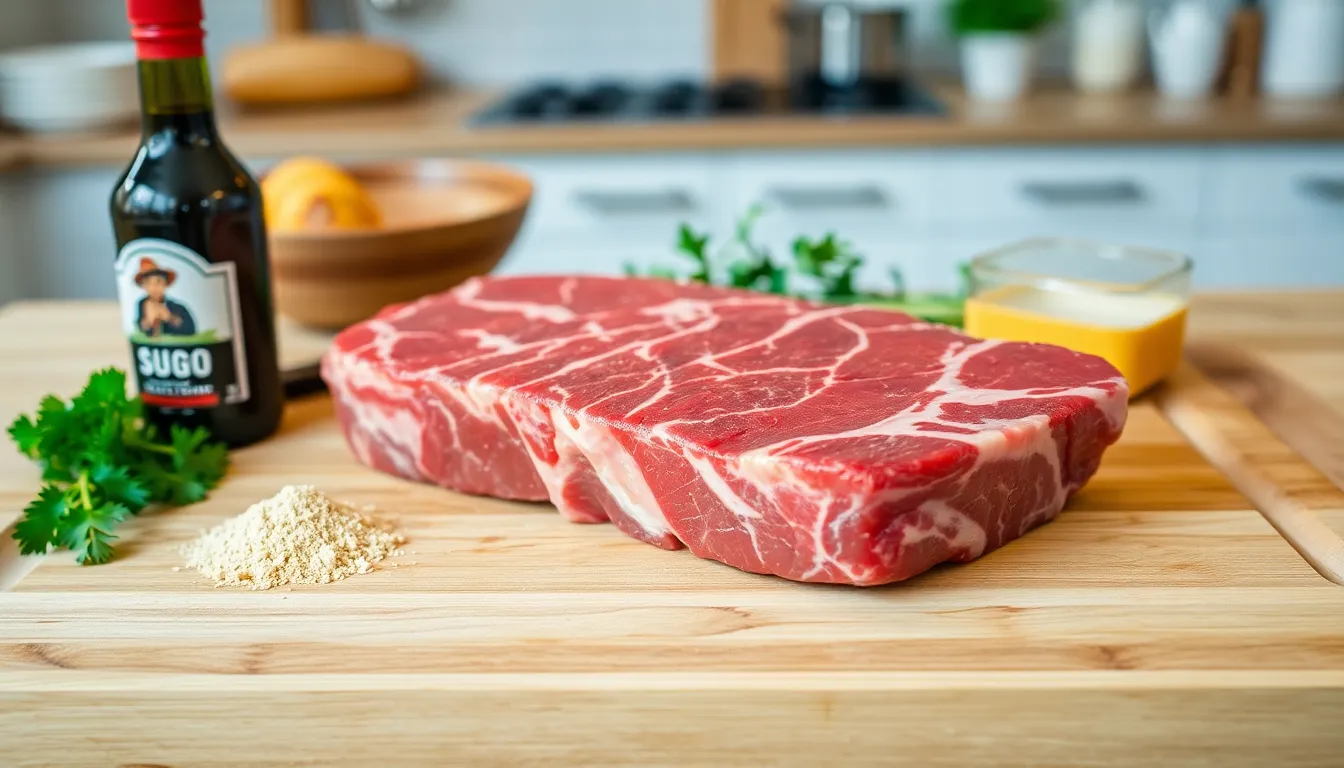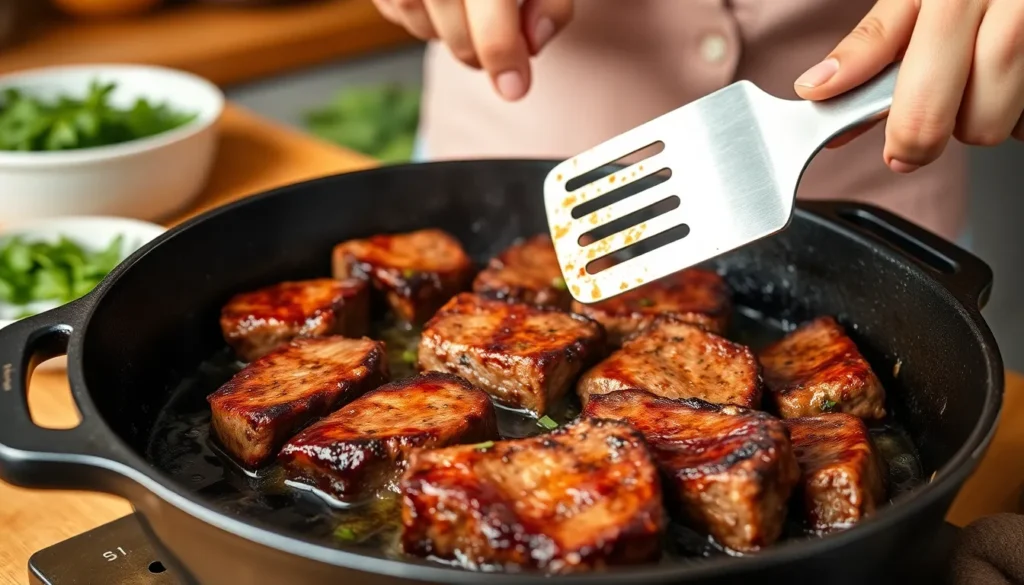Steak lovers unite! If you think cooking a perfect steak is reserved for fancy grills and high-end restaurants, think again. With just a few tips and a trusty stovetop, anyone can turn their kitchen into a sizzling steakhouse. Imagine the aroma wafting through your home, making your mouth water as you prepare to impress friends, family, or even just yourself.
Cooking Steak Tips on Stove
Understanding the various cuts of steak enhances the cooking experience. Different cuts offer unique flavors, textures, and tenderness.Popular Cuts for Steak Tips
Filet mignon ranks among the most tender cuts. It features a mild flavor, making it versatile for various seasonings. Ribeye boasts rich marbling, providing a juicy and flavorful experience. New York strip enjoys popularity due to its balance of tenderness and flavor. Sirloin offers a leaner option without sacrificing taste, often used for stir-fries and other dishes. Flank steak excels in grilling, known for its intense flavor and ability to absorb marinades.Choosing the Right Steak
Choosing the right steak depends on personal taste and cooking methods. Consider the cooking time; thicker cuts, like ribeye and New York strip, work well for stovetop cooking. For quicker meals, thinner cuts, like flank and sirloin, require less time while still delivering excellent flavor. Look for marbling in the meat; higher marbling generally indicates better flavor and tenderness. Freshness matters, so purchasing from a reputable source ensures quality. With these factors in mind, selecting the perfect steak becomes a straightforward process.Preparing the Steak

Marinating vs. Dry Rubs
Marinating works well for tenderizing and infusing flavor. Liquid and acid-based marinades often include ingredients like soy sauce, vinegar, or citrus. Using dry rubs enhances the steak’s natural flavors without altering its texture. Popular rub ingredients consist of salt, pepper, garlic powder, or smoked paprika. Both methods improve taste and can complement different cuts. Experimenting is key to finding personal preferences.Bringing Steak to Room Temperature
Allowing steak to come to room temperature ensures even cooking. This process typically requires 30 to 60 minutes outside the refrigerator, depending on the thickness. Placing it on a cutting board helps speed up the warming. Cooking a cold steak can lead to a seared exterior and an undercooked center. Achieving a consistent doneness becomes easier with this small step in preparation.Cooking Techniques
Cooking steak on the stove requires specific skills and knowledge for optimal results. Mastering these techniques enhances the cooking experience and flavor.Skills for Cooking Steak Tips on Stove
Understanding steak cuts plays a crucial role in cooking. Choosing the right cut can significantly affect tenderness and flavor. Familiarity with different cooking methods, such as searing and grilling, contributes to achieving the desired doneness. Utilizing a heavy skillet or cast-iron pan allows for even heat distribution. Additionally, knowing when to flip the steak ensures even cooking. Seasoning adequately before cooking amplifies the steak’s natural flavors. Lastly, using a meat thermometer helps in monitoring internal temperature, providing precise doneness assurance.Timing and Temperature Guidelines
Timing affects the success of cooking steak. Preheating the skillet for about five minutes creates an ideal sear. Cooking times vary with thickness; for example, a one-inch steak typically requires four to five minutes per side for medium-rare. Maintaining a temperature of 450°F to 500°F in the skillet ensures a good crust forms. After cooking, resting the steak for five to ten minutes allows juices to redistribute, enhancing flavor and tenderness. Measuring internal temperatures is essential; aim for 130°F for medium-rare and 140°F for medium.Flavor Enhancements
Bringing out the best in steak involves the right flavor enhancements. Various strategies can elevate the dish, ensuring a mouthwatering result.Seasoning Options
Salt enhances the natural flavors of the steak. Freshly cracked black pepper adds depth and a bit of heat. Garlic powder imparts robust flavor while onion powder provides sweetness. Additionally, a splash of soy sauce or Worcestershire sauce brings umami richness. Consider using fresh herbs like rosemary or thyme during cooking for aromatic notes. Each option contributes unique taste, inviting a personalized approach.Adding Sauces and Sides
Sauces can transform a simple steak into a gourmet meal. Chimichurri offers a fresh, herby punch, while béarnaise adds creamy richness. Pan sauces, made from steak drippings, bring incredible flavor when reduced with wine or broth. Pairing with sides like garlic mashed potatoes or sautéed asparagus complements the steak’s richness. Salads tossed with vinaigrette can provide a bright contrast to the meat’s savoriness. By choosing wisely, these additions enhance the overall dining experience.Serving Suggestions
Enhancing the dining experience with steak calls for thoughtful serving suggestions. Proper pairings and appealing presentation elevate the meal’s enjoyment.Recommended Pairings
Classic accompaniments complement steak well. Garlic mashed potatoes offer creamy richness that contrasts nicely with savory flavors. Fresh salads add a bright crunch, often balancing the meal’s heaviness. Grilled vegetables bring a smoky note, enriching the dish’s profile. Additionally, red wines like Cabernet Sauvignon or Malbec pair beautifully, enhancing the steak’s flavors with their bold profiles. Consider chimichurri or béarnaise sauces for those seeking more depth. These elements create a satisfying and balanced plate for a refined meal.Presentation Tips
Presenting steak artfully enhances the dining experience. Use a clean, white plate to make the colors pop vibrantly. Slice the steak against the grain for an appealing look and tender texture, placing the slices fanned out on the plate. Garnishing with fresh herbs, such as parsley or thyme, adds a touch of elegance. Drizzling the sauce over the steak rather than drowning it allows the dish’s natural beauty to shine. Finally, consider serving with a colorful array of sides, drawing attention and creating an inviting atmosphere.Conclusion
Cooking steak on the stove can be a rewarding experience that brings the flavors of a steakhouse right into the home kitchen. With the right techniques and a bit of practice anyone can achieve a perfectly cooked steak that impresses every time. Understanding the nuances of different cuts and mastering essential cooking methods can transform a simple meal into a culinary delight. By focusing on quality ingredients and proper preparation home cooks can elevate their steak dishes to new heights. Whether it’s experimenting with seasonings or pairing with delicious sides the possibilities are endless. With these tips in hand anyone can confidently create a memorable steak dinner that satisfies both taste and presentation.
By focusing on quality ingredients and proper preparation home cooks can elevate their steak dishes to new heights. Whether it’s experimenting with seasonings or pairing with delicious sides the possibilities are endless. With these tips in hand anyone can confidently create a memorable steak dinner that satisfies both taste and presentation.

